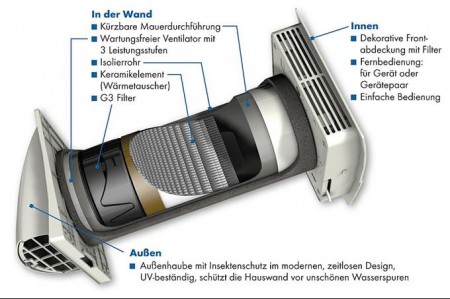Energy Recovery Ventilator ERV Pros and Cons
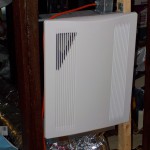 The article below describes all the pros and cons of ERVs (Energy Recovery Ventilator) that I have come across; however, the list is still not complete as I’m not an expert, just a hands-on DIY installer and owner of two ERVs.
The article below describes all the pros and cons of ERVs (Energy Recovery Ventilator) that I have come across; however, the list is still not complete as I’m not an expert, just a hands-on DIY installer and owner of two ERVs.
How an Energy Recovery Ventilator Differs from a Window
Now that I had this Panasonic ERV FV‑04VE1 for two years I know a few things about it and ERVs in general: how it performs and how it feels. (I also wrote a Panasonic ERV FV‑04VE1 review)
Advantages of ERVs
Security
Open windows make it easy for burglars. You can leave the ERV on but you wouldn’t leave windows open when you go on vacation.
Insect Entry to the House
Insects should have a more difficult time to enter your house when you ventilate using an ERV; however this depends very much on the intake wall cap, the installation height, and ERV filter types.
Energy Recovery
Energy recovery is the obvious marketing message. You wouldn’t want to trash money literally out the window, would you?
Recovery of Moisture
You barely hear about this very important feature. In the winter, moisture recovery is very important. You want your house at 30-50% relative humidity. Too low and you get sick, nosebleeds, electrostatic charges, and it’s generally uncomfortable. Too much and condensation and mold will conquer your living space. ERVs allow moisture to pass from one side to another. To be precise, as it is with heat, the ERV’s core allows moisture to go from the high side to the low side, balancing things out, sort of.
Continuous Ventilation
When you ventilate all the time a little bit it’s better than ventilating a lot for a short time. Continuous air streams can be low CFM. This Panasonic ERV blows 20 or 40 CFM and is almost unnoticeable.
Noise Reduction
ERVs make noise too but the outside noise can be much higher if you live near traffic areas.
Air Filtration
Bugs and other particles may be filtered by the ERV filter before they reach your house’s interior and your lungs.
Overall Comfort
When there is a storm outside or it’s windy, the ERV will continue to work well, whereas open windows will likely cause property damage or at least discomfort and wet interiors.
When it’s uncomfortable outside (foggy, very humid, very dry, very cold or hot) ERVs bring in fresh air that is comfortable by recovering moisture in the winter and by reducing the moisture of outdoor air in the summer. The temperature is close to room temperature except on days where outdoor temps are below freezing or above 30C / 80F.
No drafts occur with ERVs if the installer did a very good job distributing the fresh air flow. This is hard to do, however, in renovation projects.
Air Pressure Balance
Pressure inside the house is different than that of outside when the house is being heated or cooled. Even though ERVs pump the same amount of air in and out, the pathway to the outside is always open. ERVs may be able to help reduce pressure differentials, depending on how they are installed, and reduce the Stack Effect, see http://www.greenbuildingadvisor.com/stack-effect-when-buildings-act-chimneys
Fresh Air and Oxygen Enter and Harmful Chemicals and CO2 Are Pumped Out
This is a huge deal if you think about it. Indoor pollution can be much greater than outdoor pollution! Radon, building materials, and all sorts of things in the house, including your toddler’s butts, produce odors and more serious emissions. Many times the odor originates from harmful chemicals, for example in paints, adhesives, carpets, OSB, insulation, and even furniture. Over time the chemical concentration increases in indoor air, especially at night. An ERV can ventilate these out of the house while you sleep so you don’t need to worry about your open window while trying to get some rest.
Effects of Fresh Air And Higher Oxygen Levels
I also installed an ERV in the office space as well as my entire house. The effect on sleep quality is amazing. It’s obvious but it’s still amazing to discover it again and again: we found fresh oxygen does have a positive impact on productivity and fatigue in the office, too.
Disadvantages of ERVs
Now we come to the points a sales team won’t tell you 🙂
Inefficiency
Most ERVs I found in the U.S. use the cross-flow design, reaching about 65% efficiency. Here is a pic of the interior of another ERV I own, a Fantech, but the Panasonic has the same kind, just smaller:
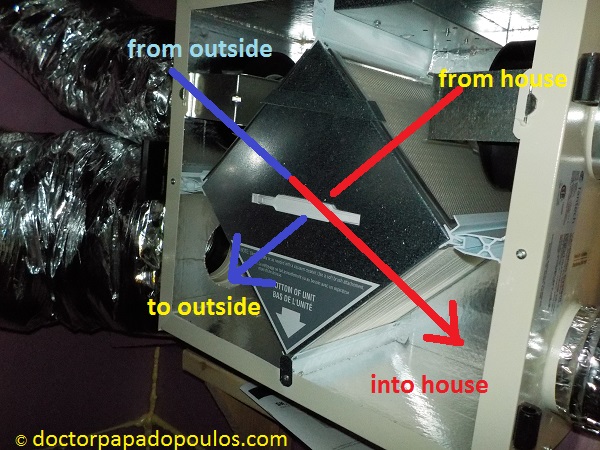
This type of design is not the most efficient one. Because of the way the two air streams flow through the core perpendicularly, only about 55 to 65% of energy and moisture are recovered. Also the material and size have an impact on efficiency, too. A design that is much better and surpasses 90% efficiency is counter-flow: when one stream enters from the left and the other from the right. I don’t have an ERV like that but I do have a water-to-water heat exchanger I can show you to illustrate how it works:
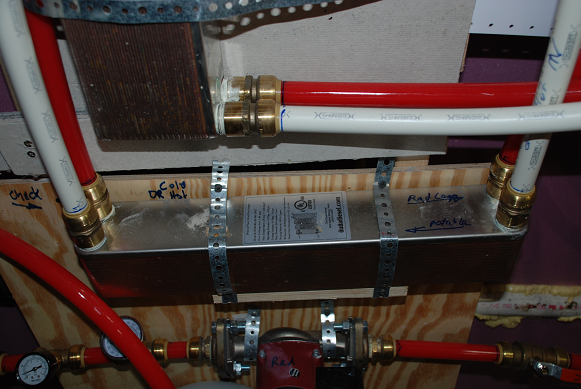
The above heat exchanger in the middle uses 40 plates (20 isolated chambers). Hot potable water enters at the right and leaves cold from the left. The cross-flow arrangement is such that the other stream of water (to be heated, the radiator loop) enters at the left and leaves at the right. Hence, at the very end the radiator loop water ‘touches’ the hot incoming potable water heat and approaches its temperature.
An ERV I found abroad for about $300 does have this type of design, it’s a Marley MEnV180. I don’t own it so I can’t comment on how efficient it works; however, it does have a few interesting features. The core is made of a ceramic material instead of the plastic kind used in the Panasonic and Fantech ERVs I have and uses a cross-flow design. Note that walls in Europe are built with insulated brick and have stucco on both sides, so the total wall depth can sometimes exceed 12″. I would assume for the cross-flow design to work, it would definitely have to be at least 8″ long.
Electricity Usage
The cost of electricity here in Baltimore is $0.17 per kWh, including taxes, charges, fees, and the Mayor’s strip club expenses.
My two ERVs (Panasonic and Fantech SE704) each use 40 Watts/hour, which totals $0.3264 per day, $9.80 per month, $117 per year.
$117 a year for fresh air in the whole house may seem it’s a lot and actually it is!
However, apart from better health, home security, and comfort, the fresh air can actually lower heating and cooling bills, too. For example, in the summer the upper floor may heat up faster than the lower floor. But with the ERV turned on and given that ERVs aren’t perfect with their heat exchange, some of that heat escapes through the ERV and that, in turn, reduces the need for additional cooling. In some periods of the year, certain hours of the day, and in some climates, the house may be much warmer than the outside air, for example in the evening after a hot summer day. Again ERVs may be helpful bringing in colder outdoor air and reducing the load on the air conditioner. A/Cs use many kWatts just to start up, so the ERV can “earn” its 40 W/h fairly easily. I guess perhaps 20% of the ERVs operating costs may be recovered this way.
Other ways the ERV may help lower bills depend on how it was installed. Apart from recovering energy, ERVs also ventilate. I set up my larger ERV to blow air into the living room on the main floor and take air from the basement out of the house. This creates an unnoticeable air flow which is convenient as it spreads the radiator heat nicely between the two floors. This arrangement also allows the air to mix better (I use a floor register) and use less energy in house for heating and cooling.
Some ERVs have dual speeds, like the Panasonic I have upstairs; however, it may be wiser to use the high speed setting and a simple timer. When you look closely many ERV manufacturers sell timers as accessories. It’s likely more efficient to turn a fan on and off 50% of the time rather than to have it run at 50% speed, as it will likely consume more than half the energy at the lower speed setting. Hence, you could buy a slightly larger ERV and run it just 30-50% of the time to save electricity.
Noise and Discomfort
When you don’t ventilate your house, i.e., there is no ERV and all windows are shut, the house should be relatively quiet. But since ERVs pump air at higher velocities, it may be too noisy if installed too close to bedrooms or living rooms. In part this point is more about installation than the ERV device itself. Ideally you would want to bring the air in from the ceiling so it has time to mix. Also a diffuser should be used a large diameter duct, to reduce velocity and noise.
Another point that is debated is where to bring in the fresh air. Bedrooms are always recommended since we sleep eight hours (shouldn’t we?) and spend a lot of time there, relatively. I disagree, however. If you live in a cold climate where temperatures drop below freezing or far into the single digit F (-20 to -30 C) you will find that the air is so dry, it’s simply unhealthy without a humidifier. Unless your ERV runs through the A/C ducts AND you have a whole house humidifier, you will find it very uncomfortable to bring in fresh outdoor air without pre-humidification.
But since your A/C is not always on, you would need to couple the ERV to the A/C, which isn’t a smart way in my opinion. I no longer use forced air heat (see “16 Pros and Cons of Forced Air Heating Systems”) and hence if I would bring fresh air directly to the bedroom it wouldn’t go through a ducted humidifier. Unfortunately, when you take outdoor air below freezing and heat it without adding additional moisture, the RH will likely be around 10-15%, which isn’t only uncomfortable, it’s unhealthy. And bringing this air directly to your bedroom wouldn’t be a smart move. For now I pump the air to the living room instead where a portable humidifier is close by. In addition, on very cold days I have a timer on the ERV to minimize ventilation since it scoops out all moisture from the house rather quickly.
When you are about to install an ERV you’ll need to plan well ahead and go through the extreme weather scenarios and see how they impact indoor comfort. Very dry or humid and very hot and cold extremes need to be dealt with somehow. Also the exact location of air outlets and intakes can make a huge difference. If it’s an old house, it gets even more complicated because of ducting:
The Need For Additional Air Ducts
Depending on how you install the ERV (manufacturers offer example diagrams) you may need to add a substantial length of air ducting to your house. Not only does this cost money directly, it also increases indirect costs: you may need to insulate and hide these ducts later on, too.
Holes and Wall Caps
Let’s not forget you need to drill one or two 5-6″ holes to outdoor walls and buy high-quality wall caps. Apart from labor and cost, they also affect the cosmetics of the house. And, where exactly are you going to drill and take air from? You would want to be able to hide all ducts indoors but yet stay away from driveways, gas appliances, and other sources of pollution.
Wall caps are usually plastic or galvanized sheet metal. I would greatly recommend a wall cap with larger diameter than the ERV has, with backflow preventer and insect screen. Also I tried to install the intake as far up as possible, far from streets and driveways, and away from crawlspace vents. The Panasonic ERV FV-04VE1 comes with a dual wall cap which is an intake and exhaust in one and requires just one 5.5″ hole, see image below to the right.
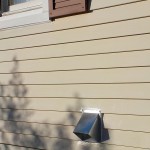
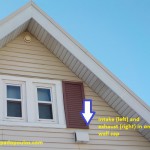
Maintenance of ERVs
When you own an ERV you have even more things to do: clean filters and vacuum the core. In spring and summer more often than during the winter. I vacuum cores several times a year and filters every month.
Price
Last but not least overall cost. ERVs aren’t cheap to run, they aren’t cheap to purchase, and installation can cost more than the ERV itself. If you do it all yourself you should recover the costs within five years (comparing ERV performance to open windows). But if you hire to get this done, you’ll pay for materials, labor, and you’ll pay for additional heating and cooling probably 10-25% more.
Whether your house “stinks” enough to pay for all this is obviously your decision. I decided to try it out and concluded the expense is worth it, especially the improvement in sleep quality is remarkable.
Other Areas of Interest
I also work a lot with Hyper-V backup. Feel free to connect if you work in the same area or have questions.
